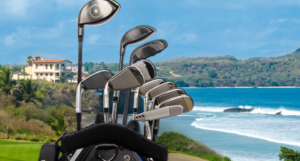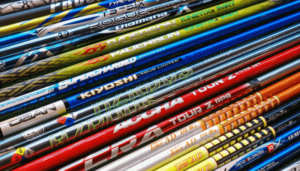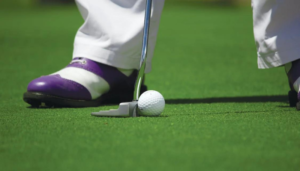Finding clubs that are right for your needs is essential to making your swing more efficient. This two-part series explains the process, focusing on Woods and irons to provide you with an understanding of how custom-made clubs can aid in becoming more efficient at golf.
Should I Get Custom Fitted Golf Clubs?
The answer is simple: yes, purchasing custom-fit golf clubs is worth it. If you looked at the back of a standard set of golf clubs from the store you’d see distinct markings along with the angles of lie and loft. The reason for having your clubs custom-fitted is to provide you with the best overall experience, by making sure the clubs aren’t going through the ground prior to reaching the ball, and increasing your chances of hitting straight.
If you were asked to list the basics of golf many would respond with things like keeping your head down, maintaining your left arm straight, and making sure that your swing is in a straight line. These are, without doubt, the foundations of a successful game, however among the most crucial aspects of golf occurs before you enter the golf playing field: getting a set of customized golf clubs.
Although many amateurs complain that they’re not competent enough to care about making each club unique that they carry, It’s a fact the use of a club that doesn’t have an appropriately matched shaft length, weight, flex, and loft/lie angles could result in overcompensation and eventually hinder players from developing the correct shape.
What Is Involved in Club Fitting?
There are several methods to determine your ideal setup. When you have your specs, you’ll know the length and lie, shaft, and grip that you require to get the best fitting clubs. What you need to be aware of these fundamental specs:- It begins with length. The proper length places you in an athletic posture and allows you to repeat your swing.
- The next thing to consider is the angle of lie. Lie aids the golfer in moving across the turf to get more consistency in results in addition to helping to counter misses.
- After that, you’ll have to pick the right shaft and your flex. It’s crucial to have the proper fit to the correct load and flex on your shafts so that you achieve the distance and accuracy from your shots.
- Then, you’ll choose the grip you want to use. Although grips largely depend on individual preference, you’ll need to determine what type is best suited to your hand size and sensation and the climate you engage in.

Finding the Correct Club Heads
If it’s all about pure aesthetics, the club’s head gets the crown. This is the place where golf’s history meets contemporary computer-aided design to create the perfect blend of the past and the future. Things have changed drastically since the time when woods were actually made of wood and irons were literally comprised of iron. The golf head of today comes with a myriad of shapes, weights, and materials. In case the options overwhelm you allow us to break down the four major elements of a golf head:- Shape/Size: Especially when selecting the driver or wood, the size can make an impact when it comes to your shot. The standard is that clubs that have greater cubes of centimeters (CCs) and bigger sweet spots are more accommodating and provide more control when making contact. For golfers looking to control ball flight and aim for different types and forms of shots, you might want to consider driving with less than CCs.
- Loft The other thing to consider is the angle you’d like to have on the face of the driver, which is typically somewhere between eight and fourteen degrees. The ideal loft is determined by how the golfer prefers to hit with the club, whether they strike upwards and raise the ball up into the air, or strike down and through like an Iron. However, an excellent place to start is to look at the speed at which you hit the ball. The slower speed of your swing will require a higher loft to lift the ball into the air to improve hanging time as well as longer distance shots. On the other hand, more rapid swings (and the speed of your ball) produce lift by themselves and don’t require the same loft. A majority of the drivers of today can be found in (or adjustable in) “draw bias”. This is the method of shifting the weight of the club towards the heel, which will significantly decrease a player’s missed shot to the left or help promote an effective “draw” swing that is likely to turn towards the left (for right-handed players).).
- Offset is how much at which an edge on the face of the club is offset from that of the shaft’s leading edge when it joins the clubhead. A greater offset in golf clubs simply gives the face the chance to “square” when it hits the ground and aid golfers (right-handed) to lessen missed shots toward the left.
- The Lie Angle Ensures that the ball is exactly on the ground to stop the heel or the toe of the ball from digging by impact. Loft angle, as well as the lie angle both, work together to make precise shots. If the golf club isn’t in a straight line at the point of impact instead of throwing the ball in the air, it will be thrown towards one side or opposite, as an angle that is sidehill will result in. Here’s an illustration. For a typical male’s clubhead’s distance and speed If you execute a flawless swing using 7 irons and the lies are off by one degree, it could make the ball go off by 7 yards. If your lie and loft angles aren’t in line with your swing, you’ll risk not hitting your target even with a flawless swing! The topic of lie angles is usually discussed in conjunction with lofted clubs, however, some drivers and woods come with modifications to accommodate those who require upright clubs.
Make Sure the Shaft Fits Your Swing
There are three main aspects to consider when choosing the shafts you use for golf: length, flex, and torque. This is how each functions with your swing.
- Flex golf clubs are classified into five different kinds of flex. Each Flex is specifically designed to meet the specific “load” parameter. “Load” is the result of the Club Head Speed (CHS) within an arbitrary time frame. If two players have the same length back-swings and length, but player A produces 90 mph CHS, and player B produces 100mph CHS, then player B will be the greater “Load’. However, when two players share the same CHS but one’s backswing is much shorter, “A” is likely to create more burden. A stiffer shaft is recommended.
(X) shafts can be used designed for those who are big hitters who regularly average over the 275-yard mark when they get into the tee or hit a ball at or over the speed of 105 mph while playing at a high pace. An X-stiff flexible (S) is suitable for players who average around 250 yards or swing between 95 and 105 mph at a moderate tempo.
The standard Flex (R) is designed for players who hit between 220-250 yards or hit between 81 and 95 mph at a steady speed. The Senior Flex (A) is designed for players who have a range of 200-230 yards or who swing the driver 70-80 mph at a smooth speed. Then, there’s women’s flexible (L) for players who can hit less than 200 yards or who swing less than 70 speed. It is the length that swings are also a crucial aspect to consider in this.Golfers who have a longer swing that sees the shaft become nearly parallel to the ground towards the top of the swing will require a soft and lighter shaft since they will have more time to feel the clubhead throughout the swing. If you’ve got a shorter swing that might be able to reach 12 o’clock only at the top of your backswing, then you should look at a more rigid shaft as the swing will have a faster pace. Some prefer a soft stretch because it gives them greater control and allows them more control and a smoother swing. But, if your shaft isn’t strong enough, you could allow the ball too high of a loft. It is essential that the speed and the length are in line with your flexibility.
If the shaft feels too rigid, it will hit too fast and will not generate enough spin. If it’s too soft, you’ll be able to apply too much spin to the ball, and you’ll reduce distance and consistency.
- Length: Having the proper length of your clubs is vital for a successful swing. Here’s a great general rule of thumb: A appropriate-sized 7 iron, raised, should be close to the upper part of your pocket. The typical American male measures 5’9″-5’10”, so anyone between 5’8″-5’11” will typically be accommodated in normal length clubs. The general rule is that any two inches above or below the standard height, you’ll have either add or subtract a quarter-inch or from the standard length of your club.
- Torque The term “torque” refers to how the club’s shaft rotates when you strike your golf ball. If you are a right-handed golfer and miss towards the left will gain greater torque, so the club will torque open while the ball is torqued shut (or lower right). A right-handed player who hits to the left may require lesser torque to straighten their missed shots.

The Grip of Your Club
It is also the golfer’s link to the golf ball. It should feel natural within their fingers. This crucial part of fitting a club relies heavily on individual preferences.
A majority of golfers prefer their hands to be able to close around the club, but without the middle finger and two fingers of the left hand. This is without cutting into the finger’s heel. Most golfers prefer a slightly bigger grip. A bigger grip will assist in maintaining the lower pressure on your club and allow you to hit the ball faster, and increase acceleration and length. This lighter pressure could help reduce fatigue in the hands, making larger grips ideal for golfers suffering from tendonitis or arthritis.
The texture is crucial to have a great feeling in the hands of golfers. Grips can be classified into three different types of feeling, the difference is due to your personal preference. There are rubber grips that are tacky with a lot of stickiness. Abrasive corded grips cause tension between grips and gloves. Additionally, the cushioned grips offer an easier feel to the palm.
SwingFit allows you to customize all of the most recent irons and drivers to match your needs and swing. Find out the factors that go into finding the perfect club here, and then answer a few questions using our Fitting Guide, and you’ll soon be on the way to improving your swing.




























































